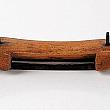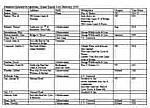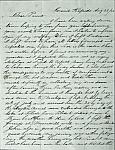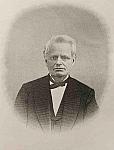Furniture Pioneers, Pre-Civil War
by William Widdicomb
The furniture industry of Grand Rapids had its birth in the system prevailing seventy (circa 1840) or more years ago in the smaller towns throughout the country. The cabinet maker produced by hand the simple pieces of furniture required, offering them for sale in his own workshop, or, when the business was sufficiently advanced, a small salesroom adjoining. Usually the cabinet maker was both workman and merchant. All of the earlier efforts at furniture making in our city were of this character.
HALDANE AND EARLY FURNITURE MEN
The first cabinet maker to appear in our valley was William Haldane, so long and pleasantly known as “Deacon” Haldane. His home and little cabinet shop were located where now stands the Michigan Trust Building (SE corner of Ottawa and Pearl). Archibald Salmon came at about the same time and had a shop near Deacon Haldane’s. Samuel F. Butler appeared not long after, locating on Kent Street, near the present Bridge Street House. Several years later Abraham Snively established a little furniture store in a building where the Morton House now stands. Deacon Haldane, the only one of these men remaining permanently in the business, passed away at a good old age not many years ago.
About the time of Deacon Haldane’s arrival David Wooster, Zephaniah Adams and John L. Smith had a chair shop about where the present gas works are located. The small stream running down from Division Avenue provided power; and here was the first furniture produced with the aid or power. There is little evidence now that a stream sufficiently large to furnish power existed at that spot, yet I can clearly recall the brook, which entered Grand River just below the lower boat landing after meandering through the lowland. The dam had entirely disappeared, but some of the timbers and other evidences of the water power were there in my earlier days. It may surprise you to know that a stream of this magnitude existed where now there is not the slightest trace of such a stream, nor even the valley through which it flowed.
In this little waterpower shop chairs were made to be peddled around the country among the few settlers. It is said this power was used as early as 1834 by Smith, yet further enquiry, which I have made does not confirm this fact. Deacon Haldane always claimed he was the pioneer cabinet maker of the valley.
WILLIAM POWERS AND OTHERS
Loren W. Page, James T. Finney and Nehemiah White, and later by William T. Powers, Albert Baxter and Cyrus C. Bemis followed these earlier settlers. Baxter’s History of Grand Rapids states that Powers and Haldane introduced working by machinery about 1847. This first use of power was on the Canal in a portion of the sash and blind shop, which Deacon Haldane’s brother was then operating, and was simply the use of the machines the brother had in the sash and blind business. About 1853 the Deacon set up a small steam engine on the bank of the river, where his cabinet shop had been located for several years, at the place now occupied by the Weston Building.
William T. Powers, on the Canal bank at Erie Street, established the first furniture manufacturing of any magnitude, with the aid of power. E. Morris Ball became a partner of Mr. Powers in 1851, with a store on Pearl Street where now the Rood Building stands (just west of Power’s Theater). Mr. Powers retired from the firm in 1855, and Ball, Noyes & Colby, continued the business. It is well known that at about this time one or two of the Pullman Brothers appeared and conducted a small furniture establishment upon Canal Street, opposite Bronson Street (later Crescent).
COMSTOCK AND THE WINCHESTERS
Enoch W. and Samuel A. Winchester built a factory at the foot of Lyon Street where the excavation had been made for a lock at the time the canal was built, the original intent of the canal being an improvement in navigation rather than a factor for producing water power. The Winchester Brothers’ store was on Canal Street where the present Nelson-Matter Company’s office is located. The severe panic of 1857 compelled the Winchesters to transfer their business to Charles C. Comstock, their brother-in-law, which date represents Mr. Comstock’s connection with furniture manufacturing. Comstock succeeded in keeping the business alive during the strenuous times and conditions prevailing after the 1857 panic until the greater activity appeared resulting from the war, and in 1863 formed a partnership with Messrs. James and Ezra Nelson, the name becoming Comstock, Nelson & Company. In 1865 T. A. Comstock, Mr. Comstock’s son, was taken into the firm, also Manly G. Colson and James A. Pugh, who were foremen in the manufacturing departments, the firm name changing again to Nelson, Comstock & Co.
WIDDICOMB, BERKEY, AND MATTER
In 1857 George Widdicomb rented a room in the pail factory, south of Bridge Street Bridge, then operated by David Caswell, whose store on Canal Street directly opposite Bronson Street.
The present Godfrey residence, east of Fulton Street Park, was occupied during the early war days by Henry Wilson as a cabinet shop. He was the first cabinet maker to produce furniture of fine quality. No doubt there are still pieces of furniture he made in Grand Rapids. Prior to that time any expensive furniture was shipped from the East by way of the Lakes and Grand River to the city. I recall some very sumptuous furniture brought here by Dr. Shepard about 1858, it having been seriously injured in transit, and my father was called upon to make the necessary repairs.
While my father had shipped furniture to Milwaukee prior to the war, the manufacturing business, as we understand it today, was established by Julius Berkey in 1860, with Alphonso Hamm as a partner, in a small shop on Erie Street. Chicago was the market for what they produced. The partnership was soon dissolved, for Mr. Hamm was an exceedingly visionary man and there could be no accord between him and a man of Julius Berkey’s energetic and prudent character. Later Julius Berkey occupied a small portion of the second floor in a factory building built by William A. Berkey in the fall of 1857, where the present Berkey & Gay Company’s factory now stands. It was a great barnlike structure of two floors, 50 by 100 feet in dimension, used as a planning mill and sash, door and blind factory. William A. Berkey was a very hopeful man and felt confident the day was not far distant when he could develop sufficient business to occupy these great premises. The times were very stringent and this hope was not realized until the years following the war. Julius Berkey’s small part of the second floor was enclosed from the remainder of the open lofty building, and there he engaged in making a walnut table, which was soon known as the “Berkey table,” a little, inexpensive affair and the origin of the widely-known and magnificent Berkey & Gay business. Mr. Berkey continued the business with a fair degree of success and in 1862 formed a partnership with Elias Matter, Mr. Berkey, perhaps, having the experience and Mr. Matter a very small sum of money as capital.
JULIUS BERKEY & ELIAS MATTER
Let me say a word of my personal recollection of each of these two men (Julius Berkey & Elias Matter). I came to Grand Rapids October 1, 1856, and found employment immediately with the Winchester Brothers, boarding at a small place on Kent Street, where stands the Bertsch Building (Barclay, Ayers & Bertsch Co.). My mechanical instincts led me down to the sawmills on the canal in the evening after the work of the day. There, in a planning mill on the south side of Erie Street where now stands the Bissell Company’s office, I saw a fine looking, stalwart young man feeding pine strips into a flooring planer. As I watch the work with much interest the young man greeted me pleasantly, and I remarked that I had worked some in a planning mill at Havana, New York. I made other visits to him during the fall, and thus my acquaintance with Julius Berkey began. From that day to his death our acquaintance was intimate and pleasant, Mr. Berkey’s courtesy and ability always commanding my respect and esteem.
Before the (Civil) war days Elias Matter was working as a chair maker in the Winchester shop where I had found employment, and during the winter months, when business was dull, he took up the occupation of school teaching—was a successful country district school teacher and, as I clearly recollect, a man of exceptional energy. I recall when he was teaching district school at what is now known as Ravenna, then Crockery Creek. He taught school for $18 a month and five evenings out of the seven gave writing lessons in several district schools from tow to six miles distant from his own school, at $1 per term of twelve lessons. Mr. Matter would walk this distance each evening after his own school was closed, teach the writing school until 9 o’clock and walk back to where he happened to be boarding under the old system of “boarding round” for the teacher. Mr. Matter accumulated a modest sum in this manner, and this was the money which enabled him to become Julius Berkey’s partner, his capital being about the same as the value of Mr. Berkey’s machinery, which had been made almost entirely by his own hands. I will have a word or two more to say later on regarding Mr. Berkey’s vigorous personality and the manner in which he so successfully developed his business.
Buddington & Turnham (C.O. Buddington & James V. Turnham) made an effort at manufacturing sometime in 1862. The Commodore conducted an auction store on Monroe Street in a little building adjoining the Rathbun House. As I was in the war I have no knowledge of what persuaded the Commodore to enter into a business of which he was totally ignorant, unless it were Mr. Turnham’s persuasions. They were an illy assorted pair and did not continue long in existence, but did produce two of the capable furniture manufacturer of our city, E. J. Foote and John Widdicomb, who when they came from the Army, took their earlier lessons there.
Note: Both Clossen O. Budington and James V. Turnham are listed in the 1865 census as furniture dealers. W.R. Budington, a relative, is a cabinet maker with the company. By 1868 Budington & Turnham have fourteen employees: 6 cabinet makers; 3 machinists; 2 turners; and 3 laborers. By 1872 both Budington and Turnham have move on to other occupations, but appear to have existed from at least 1862 - 1868, if not a little longer. Avertisement from 1868-69 City Directory.

Excerpted from, The Early History of the Furniture Industry in Grand Rapids, by William Widdicomb. Grand Rapids Historical Society. 1909. Grand Rapids Public Library, Coll #141-20-3
Return to Photo Essay

 facebook
facebook








